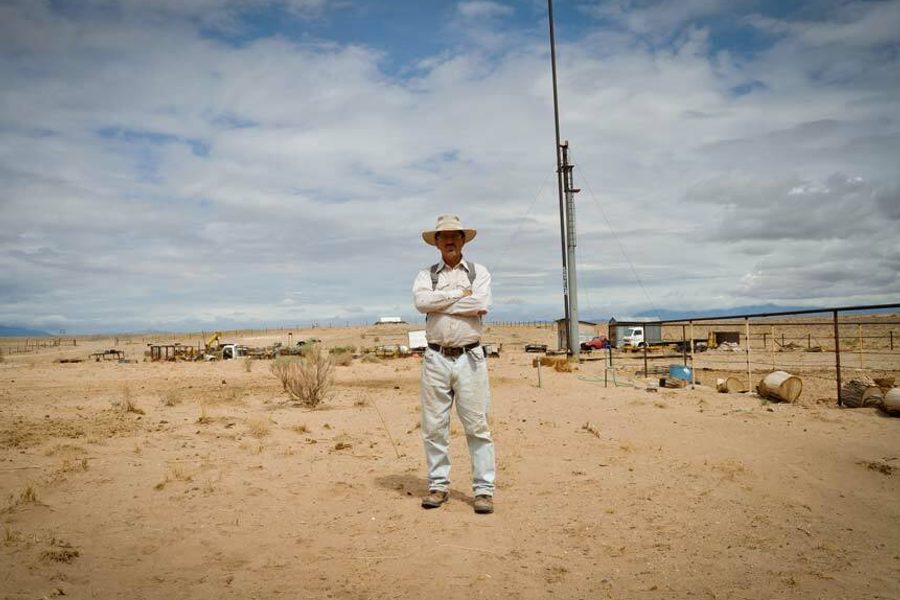New Mexico’s Badlands
In low-income colonias, the state’s unregulated real-estate market allows predators to thrive.
Joseph Sorrentino

Pajarito Mesa is a tough place to live. Just 10 miles or so from downtown Albuquerque, N.M., it is 18,000 acres of flat, windswept desert dotted with stunted shrubs and the occasional cactus or tree. Some 1,200 to 1,500 people live there, a handful in cinderblock houses, most in a haphazard assortment of old trailers and RVs.
For years, residents had to drive into Albuquerque to get water, but in 2010, Bernalillo County finally put in a water station. People pull up in pick-up trucks to fill 250 or 500-gallon tanks with a hose. On weekends, waits can easily stretch more than an hour.
“It’s on the scale of a developing country,” says Albuquerque attorney Craig Acorn, who has done legal work with residents of Pajarito for several years. The mesa is off the electrical grid, so residents use solar panels or gas generators to make their own, often sporadic, electricity. There are no paved roads, just rutted dirt paths. Heavy rains flood the paths, sometimes leaving them so badly cratered that people make new ones by simply driving across a dry patch nearby. Flooded roads often prevent children from reaching the only school-bus stop, located next to the water station, so they simply miss school.
The area attracts people who know that if they need something done, they’ll have to do it themselves. Usually, they won’t even ask neighbors for help. “It’s not a half cup of sugar kinda community,” says Carlos Proffit, who has lived at Pajarito for almost 30 years.
“Somebody comes knockin’ on your door, it’s something serious.” Despite the hardships of living without the basic amenities most Americans take for granted, the lure of cheap land and a shot at owning a home — the quintessential American Dream — attracts people who can’t afford to live elsewhere. It certainly attracted Sandra Bustillos and her husband Jesús García Silveyra. “We thought it would be easy to buy land,” says Bustillos, whose sad, tired eyes contrast with her animated speech and movements. “Here, because there is no electricity, no water, it is … cheaper.”
The couple bought an acre and a quarter of bare land for $20,000, figuring that since García works in construction, they could build a home with help from friends. They gave the seller, Tomasita Atencio, a down payment of $8,500. With monthly payments of $1,000, they paid off the balance in a year. “We never missed a payment,” says García, 37, a large man with a gentle demeanor. “We wanted a place to live, a piece of land.”
But after paying it off, they say, they learned that Atencio was selling them land she didn’t own. They now face eviction, which means losing everything: their $20,000, the land and the cost of improvements such as their trailer, a fence, plants and a water tank.
Theirs isn’t the only such case in Pajarito and other Southwestern communities like it. People are losing their land and their money to suspect real estate deals. They’re also buying land thinking they can live there only to learn, too late, that they can’t.
Deals for the desperate
With its hardscrabble conditions, Pajarito Mesa has all the hallmarks of a colonia — impoverished areas scattered throughout the four states bordering Mexico. Many older colonias started as labor camps in the mid- to late-1800s, when companies, especially railroads, turned to Mexico for cheap labor after the Chinese Exclusion Act of 1882 halted immigration from China. Although each colonia has its own unique features, the U.S. Department of Housing and Urban Development (HUD) defines colonias as being located within 150 miles of the border and lacking “adequate sewer, water and/or housing.” Most have high rates of poverty and unemployment. Although few colonia residents I spoke with were undocumented, many are immigrants and speak only Spanish. And while conditions have improved in many colonias in recent years, some still lack infrastructure. Texas has the most colonias, with about 2,300; New Mexico has 140; Arizona and California considerably fewer. Since Parajito is about 250 miles from the border, by HUD’s definition, it’s technically not a colonia. But it shares all the characteristics of one, and it’s in much worse shape than many.
It’s almost impossible to get a traditional mortgage from a bank to buy property in colonias. For one thing, few banks will grant a mortgage for property in an undeveloped area. For another, most people seeking to buy land in a colonia are low-income and lack sufficient — or any — credit history. So would-be owners of colonia tracts usually enter into what are known as “real estate contracts” with the seller.
A real estate contract, says Proffit, who purchased three parcels of land on Pajarito, is “an expensive way to buy real estate, [but] for poor people, it’s the only way to get in the game.” However, he adds, “It’s a gamble.”
On the surface, a real estate contract can seem like a pretty good deal. While interest can be high — sometimes 10 percent or more — upfront fees are low. “You don’t pay for title insurance, points, all the bank fees,” explains Tom Prettyman, a lawyer at New Mexico Legal Aid in Albuquerque. There’s a down payment but, says Ron Douglass, who has been using contracts to sell land in and around Pajarito for more than 40 years, those are “real negotiable.” Bustillos and García used a truck as part of their down payment. Douglass says, “When done right, [they’re] as good as gold.”
But, especially with low-income people, they’re not always done right. “There’s a gross disproportionality of bargaining power between the seller and the buyer,” says Prettyman. “The seller knows what he’s doing and the buyer doesn’t, especially [in] Pajarito.”
“One problem with a real estate contract is that it’s not regulated,” says Angelica Anaya Allen, director of the Fair Lending Center at the United South Broadway Corporation, an advocacy organization in Albuquerque. “Some sellers don’t provide full disclosures.” That includes not informing buyers of the length of the contract, the interest rate and the availability of utilities. People often don’t know that, under a real estate contract, if they miss even one payment — which low-income people often do — they can be evicted and lose all the money they’ve paid, their home, and the value of any improvements. Many people buying land in colonias are Mexican or Mexican-American, and they often speak and read only Spanish; contracts are almost always in English. Further, there’s no requirement for sellers to produce a title or title insurance to prove that they actually have the rights to the land. That’s where Bustillos and García ran into trouble. Originally from Chihuahua, Bustillos and García have been in the United States for 17 years. They were living in a trailer with their four children in Albuquerque, paying $450 a month to rent the lot, so they decided to buy some land. With no credit, the only option they saw was Pajarito, says Bustillos.
Atencio sold them a parcel, giving them a one-page contract with a couple of sentences, in Spanish, stating that she was selling them the land, the price and the monthly payments. That was it. They didn’t have a lawyer look at it. “We talked to Atencio and felt that was enough,” says Bustillos. “That is the way we do it when we buy a truck.”
When they paid off the loan, Atencio gave them a handwritten note simply stating that they now owned the land. In 2010, they moved a used trailer onto the property. They say they asked Atencio for a title, but never got it.
She couldn’t give them the title because she didn’t have it. The property belonged to Charles Wright, a large landholder on Pajarito. According to Wright, Atencio had purchased the property from him but stopped making payments, at which point it reverted to Wright. That would make her sale to Bustillos and García a “wrap” or “wraparound” contract, something that’s fairly common in colonias and technically legal. It’s when a person is buying land — doesn’t own it yet, doesn’t have title to it — and decides to sell all or part of it, often using the money from the sale to pay off their own debt.
Atencio has since disappeared, and Wright has moved to evict Bustillos and García. The couple countersued to stay on the property, claiming that Atencio was acting as Wright’s agent.
Bustillos and García’s lawyer, Leonard DeLayo, speaks heatedly of the situation. “I’ve got a guy, works six days a week, pays his taxes, buys a house … made all the payments,” he says. “These people got screwed.”
Meanwhile, Bustillos and García continue to live in their cramped, two-bedroom trailer with their four children, the oldest of whom has autism, waiting for the case to go to court. “When we first came here, thinking this would be our land, we were happy,” says García. “Now, I feel happy because I am alive, but sad for the situation.”
Bustillos and García are not the only Pajarito residents living in limbo. In fact, contract questions aside, the county maintains that most of the people in Pajarito shouldn’t be living there.
Where no roads go
As far as anyone can tell — and where Pajarito is concerned, there’s a lot of uncertainty— people started living there sometime in the early 1970s. “These were people who wanted to be off the grid,” says Acorn. By the late 1980s, it wasn’t just attracting back-to-the-land types but also low-income people looking for a place to live. Land sellers have been happy to sell parcels, and people have been happy to move onto them.
However, county officials aren’t happy. Enrico Gradi, community development manager at Bernalillo County’s Planning and Development Services, says that officials often have to tell new owners of Pajarito property, “There’s no road here.” And that’s just one of several requirements to develop a property. “If you build a house, we need to make sure an ambulance can get to you, that you have clean water, electricity,” explains Gradi. Pajarito has many dirt paths but they don’t qualify as legal roads — roads that can support the weight of emergency vehicles like fire trucks. There are only two legal roads at Pajarito, and they only partially extend into the interior, meaning there are very few parcels where people can legally live.
County officials want to stop people from moving to Pajarito, while figuring out what to do with people already there. In 2008, they erected a sign at the entrance stating that it may be illegal to buy land at Pajarito and to check with the county before doing so. The county also hired an employee, Mike Gallegos, to oversee Pajarito and perform the unenviable job of telling people that, unless they have all the requirements and permits, they can’t live on the land they’ve bought. In the rare case that they can live on a parcel, he tells them they’ll need to go through the expensive and involved process of getting permits — first for building a home, then for things like septic tanks and wells. The majority of buyers say they weren’t told about the permits (though land sellers claim otherwise).
Like Bustillos and García, Viridiana Lucero Vicencio and Omar Torres dreamt of having a home for their three children. “Someone in Albuquerque told us about cheap land here, we came out and saw signs and called,” says the 31-year-old Vicencio. They found a seller. Because the contract was in English, which they don’t understand, they trusted him. They say he left out a statement on the one-page sheet: that if they miss a payment, they could lose the land.
The couple put an RV on the land and began to move in. That’s when they attracted the attention of Gallegos, who told them that they didn’t have the requirements to live there permanently. So they eventually stopped paying and demanded their money back — to no avail. Vicencio now understands that, because they stopped paying, they’ve lost the land and their money, an estimated $10,000 to $15,000. “I believed [the seller] because he spoke Spanish,” she says. “When we spoke with him he seemed like a good person. Now I think he’s a robber; he just steals from people.” (When the seller was called and asked for comment for this story, he hung up.)
A textbook free-market failure
It’s up to New Mexico legislators to regulate real estate contracts, and they’ve been reluctant. “The first crack we had at regulation was in the 2011 legislative session,” says Acorn. “We did a very comprehensive bill, and the real estate industry was able to kill it.”
The law he wanted was based on legislation passed in Texas over several years, beginning in 1989. Erich Morales, an assistant county attorney for El Paso County, helped draft some of that legislation. “There was an increasing feeling that people were just really getting taken unfair advantage of,” says Morales. “We had folks living in … shacks made out of cardboard and other materials, using hand-driven wells near open cesspools. … Rates of infectious hepatitis were soaring; externalized costs like health care, school costs, law enforcement and infrastructure development were soaring.” There was opposition from land sellers and developers, warning that regulations would drive up costs and price low-income people out of the market. But a 2010 report showed that growth at the border continued to be strong, while there were few new substandard housing developments.
Sellers, of course, would prefer an unregulated or lightly regulated market. But in a landmark 1995 study, Northwestern University law professor Jane E. Larson studied colonias as an example of the failures of an unregulated market. “As the market advocates and land sellers would predict, land and housing [in colonias] is extremely inexpensive,” she wrote. “Housing and environmental conditions, however, are deplorable.”
“Suddenly this idyllic vision of selling people this American Dream of owning your own land was selling them a tawdry imitation of it,” says Morales. “The state of Texas, in the last 20 years, has spent a billion dollars on retrofitting infrastructure to the colonias which could have been spent for other purposes.” New Mexico has also spent millions of dollars correcting problems in its colonias, but many persist. At Pajarito, for instance, because many people are unable to get permits for septic tanks, they’re installing tanks themselves or simply digging holes. Some find simpler solutions. “I crap in a bag and burn it,” says Dean Kaehele, a longtime resident. “I pee outside but make sure no one’s looking.” Kaehele flew an American flag outside his RV until the wind tore it down a few months ago. “I’m a patriot,” he says.
In 2013, the New Mexico Senate formed a task force of real estate industry officials and advocates for colonia residents to study real estate contracts. The task force recommended that real estate contracts include, among other things, full disclosures about the property, whether it was suitable for residential use, and that title and escrow companies be used. No action is expected on it this year.
One of the reason predatory loans, like real estate contracts, exist is because there’s a lack of housing and land that low-income people can afford. Low income people rarely have sufficient income to qualify for a mortgage and they also typically lack any credit history. Tierra del Sol Housing Corporation, in Las Cruces, N.M., builds subdivisions for low-income people, but the demand far outstrips the supply.
Steve Fischmann, who was a New Mexico state senator from 2009 to 2012 and worked with Acorn on the 2011 legislation, says that there are options that could be explored. “There’s nothing stopping anybody from coming up with financing alternatives that have protections that deal with that [low-income] market,” he says. He lists low-income credit unions, community development financial institutions and city- or state-owned banks designed to serve low-income people as possibilities. Currently, none of these options is available in New Mexico. “[Sellers] just choose to go through a process that’s totally unregulated so they can abuse it,” Fischmann says.
While the New Mexico Senate studies the problem and advocates argue for regulations that the industry resists, people on Pajarito still hang onto their version of the American Dream.
Enrique Dorado (not his real name) purchased his land at Pajarito eight years ago and soon began building a house. He says he told the land seller that he was going to live there. “She didn’t say anything,” he says. He did much of the work himself, spending about $25,000 on materials alone. Then the county told him he couldn’t live there; there are no legal roads to the property and he doesn’t have the required permits. Dorado blames himself as much, if not more, than the land seller. “I didn’t ask for information,” he says. “It’s not her responsibility, it’s mine.” Despite the setbacks, he refuses to give up on his dream. “I want to live here,” he says.
This reported was supported by the Fund for Investigative Journalism.








